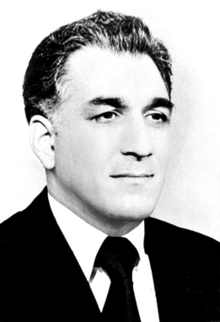Hafizullah Amin (Pashto: حفيظ الله امين; 1 August 1929 – 27 December 1979) was an Afghan communist head of state, who served in that position for a little over three months, from September 1979 until his assassination. He organized the Saur Revolution of 1978 and co-founded the Democratic Republic of Afghanistan (DRA), ruling Afghanistan as General Secretary of the People's Democratic Party.[4]
Born in the town of Paghman in Kabul Province, Amin studied at Kabul University and started his career as a teacher before he twice went to the United States to study. During this time, Amin became attracted to Marxism and became involved in radical student movements at the University of Wisconsin.[5] Upon his return to Afghanistan, he used his teaching position to spread socialist ideologies to students,[6] and he later joined the People's Democratic Party of Afghanistan (PDPA), a new far-left organization co-founded by Nur Muhammad Taraki and Babrak Karmal. He ran as a candidate in the 1965 parliamentary election but failed to secure a seat, but in 1969 became the only Khalqist elected to parliament, increasing his standing within the party.
Amin was the main organizer of the April 1978 Saur Revolution, which overthrew the government of Mohammad Daoud Khan and formed a pro-Soviet state based on socialist ideals.[5] Being second in chief of the Democratic Republic, Amin soon became the regime's strongman,[7] the main architect of the state's programs including mass persecution of those deemed counter-revolutionary.[8] A growing personal struggle with General Secretary Taraki eventually led to Amin wrestling power away then successfully deposing him and later ordering his execution; on 16 September 1979, Amin named himself Chairman of the Council of Ministers (head of government), Chairman of the Revolutionary Council (head of state), and General Secretary of the PDPA Central Committee (supreme leader).[9]
Amin's short-lived leadership featured controversies from beginning to end. His government failed to solve the problem of the population revolting against the regime[10] as the situation rapidly worsened[8] and army desertions and defections continued. He tried to change things with friendly overtures to the United States, however his reputation in Washington was tarnished by his role in the assassination of Adolph Dubs.[11] Some Afghans, especially those from minority ethnic groups such as the Hazaras, held Amin responsible for the regime's harshest measures,[12][13] such as ordering thousands of executions, more than 7,000 of which were from the Hazara minority.[12][14] Thousands of people disappeared without trace during his time in office.[15] The Soviet Union under Leonid Brezhnev was dissatisfied with and mistrusted Amin; they intervened in Afghanistan, invoking the 1978 Twenty-Year Treaty of Friendship between Afghanistan and the Soviet Union. Soviet operatives assassinated Amin at the Tajbeg Palace on 27 December 1979 as part of Operation Storm-333, kickstarting the 10-year Soviet–Afghan War; he had ruled for a little more than three months.
- ^ "Hafizullah Amin". Encyclopædia Britannica. Archived from the original on 20 May 2015. Retrieved 4 September 2012.
- ^ Misdaq 2006, p. 136.
- ^ Braithwaite 2011, p. 104.
- ^ Halliday, Fred (February 1980). "Fred Halliday, The War and Revolution in Afghanistan, NLR I/119, January–February 1980". New Left Review (I/119): 20–41. Archived from the original on 15 August 2021. Retrieved 21 July 2021.
- ^ a b "BBC Blogs - Adam Curtis - Kabul: City Number One - Part 4". 28 October 2009. Archived from the original on 16 August 2021. Retrieved 21 July 2021.
- ^ "What the CIA Did (And Didn't Do) in Soviet-Occupied Afghanistan". 26 April 2021. Archived from the original on 20 August 2021. Retrieved 23 July 2021.
- ^ Amstutz, J. Bruce (1986). "Afghanistan: The first five years of Soviet occupation" (PDF). National Defense University Press Publications. Archived from the original (PDF) on 15 August 2021. Retrieved 25 July 2021.
- ^ a b Kaufman, Michael T. (23 September 1979). "Taraki's Downfall Came Immediately After a Visit to Moscow". The New York Times. Archived from the original on 23 July 2021. Retrieved 29 July 2021.
- ^ "Coda. The Death of a President". Archived from the original on 23 July 2021. Retrieved 23 July 2021.
- ^ "Afghanland.com Afghanistan Communism Taraki Hafizullah Amin Babrak Karmal". Archived from the original on 29 January 2017. Retrieved 12 January 2018.
- ^ Tomsen 2011, p. 160.
- ^ a b Dorronsoro, Gilles (2005). Revolution Unending: Afghanistan, 1979 to the Present. London: Hurst & Company. p. 104. ISBN 1-85065-703-3.
- ^ "Library of Congress / Federal Research Division / Country Studies / Area Handbook Series / Afghanistan". country-data.com. Archived from the original on 25 December 2018. Retrieved 21 January 2018.
Yet many Afghans held Amin responsible for the regime's harshest measures and the Soviets, worried about their huge investment in Afghanistan might be jeopardized, increased the number of 'advisers' in Afghanistan. Amin become the target of several assassination attempts in early and mid-December 1979.
- ^ Conflict in Afghanistan: A Historical Encyclopedia by Frank Clements
- ^ World: Analysis: Afghanistan: 20 years of bloodshed Archived 17 February 2019 at the Wayback Machine - "another leader, Hafizullah Amin, gained prominence. He became president in 1979 and Taraki was killed. [...] But it was during this time that the bloodshed began in earnest. Tens of thousands of Afghans disappeared never to be seen again."
